Flooring: A Room By Room Guide
People often have the wrong idea about what type of flooring should go in which room.
This guide which takes you through the flooring options for different rooms of the house.
People tend to put new flooring into a house room by room, rather than in the whole house at once. This guide is therefore written so that you can go straight to the room you intend to buy new carpet or flooring for, without having to read the whole guide.
Click on any of the links below to go straight to the room you want to get flooring advice for:
When you know what room you want to buy flooring for, you need to ask yourself a list of questions, including:
- How big is the area?
- How often are you going to walk on the floor?
- Who is going to be walking on it?
- How many people are in the house?
- Have you got pets, such as dogs?
- Have you got young children?
- Do you and your visitors take your shoes off at the front door or leave them on?
- Is your floor likely to get muddy?
- Will it stand the test of time?
- What is your budget?
This document will look at five key types of flooring as it journeys through the home - carpet, wood, laminates, vinyl and LVTs (luxury vinyl tiles).
Bedrooms
By far the most popular choice for the bedrooms is carpet. The majority of bedrooms are carpeted because of the softness, warmth and underfloor luxury that carpet provides. Carpet means comfort, which you need in a room that you are likely to be walking around in bare feet. When you get out of bed and you have bare feet, it feels soft and warm. It is also available in a wide range of colours to suit any bedroom – you aren't limited with carpet.
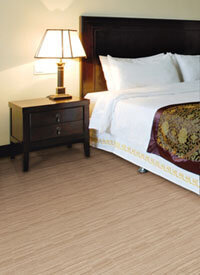 Generally, you want a good quality carpet in the master bedroom, and if people decide they want to "upgrade" a carpet, the master bedroom is usually the room of choice. It is the room you sleep in, the room you spend each morning and night in. So, it is the room you most likely want a bit of luxury in. The spare bedroom on the other hand is the room that most people looking to economise can save money in. Carpet that goes in the back bedroom will last a lot longer than carpet on the stairs. It makes sense to have the best carpet you can afford in the lounge and other high traffic areas of the house, and economise in the room that only gets used a couple of times a year. Of course, you may not choose to economise, as many people like to have the same carpet throughout the upstairs of their home.
Generally, you want a good quality carpet in the master bedroom, and if people decide they want to "upgrade" a carpet, the master bedroom is usually the room of choice. It is the room you sleep in, the room you spend each morning and night in. So, it is the room you most likely want a bit of luxury in. The spare bedroom on the other hand is the room that most people looking to economise can save money in. Carpet that goes in the back bedroom will last a lot longer than carpet on the stairs. It makes sense to have the best carpet you can afford in the lounge and other high traffic areas of the house, and economise in the room that only gets used a couple of times a year. Of course, you may not choose to economise, as many people like to have the same carpet throughout the upstairs of their home.
Not all bedrooms have carpets - it depends on your house and your circumstances. For example, you may feel that you want a particular floor to match the character of your house, or you or your family might have allergies or be badly asthmatic. If either of these scenarios applies then you could choose a wood, laminate, vinyl or LVT floor, all of which are very good for a bedroom. LVTs in particular look fantastic in bedrooms, but you need to ask yourself will you be happy with a cold hard floor in the bedroom? If you go down this route, you might want to consider underfloor heating, which should not be put under a solid wood floor, but you can put under an engineered wood floor, laminate floor or LVT floor.
Kitchen
When it comes to the kitchen, we advise against having a wood floor, as it is probably the least suitable flooring for a kitchen. You should never put wood where there is high humidity. Wood is hygroscopic, which means it works like a sponge. Wood will draw moisture from a moisture rich atmosphere and begin to gain volume and expand. When the atmosphere is dry, moisture is released out and the wood will begin to shrink. If you are desperate to have a wooden floor in your kitchen, you should really consider looking at the LVT options as they are so realistic and avoid these problems.
Patterned vinyl or LVTs are the two best options for a kitchen. Laminate is also an option, but there are drawbacks. We look at each option in turn.
Vinyl is a great option for your kitchen because it requires minimal maintenance. All that is required to keep vinyl clean is a mop. Vinyl doesn't mind water, you can drop food on it and it will wipe clean, and it is very hard wearing and robust. Some even come with a 15 year warrantee. It has come a long way since your grandmother's lino and you can now buy better quality vinyl which looks very good and are a really nice, hardwearing product; many types are textured and even have an R10 rating which means they are slip resistant.
Luxury Vinyl Tiles (LVTs) are designer floors. They have an incredible impact. People will walk in to your kitchen, look at the floor and say "Wow! That is gorgeous!" They are limited only by your own imagination and are totally unique – the possibilities are endless. That doesn't mean that they are too good for a kitchen. They are very low maintenance, only need a mop clean, and wear so well that after 25 or 30 years when maintained correctly they will still look like they were laid yesterday. The only downside can be the price because it is not an easy floor to fit. However, if the subfloor is in a good state then the price can be reasonable.
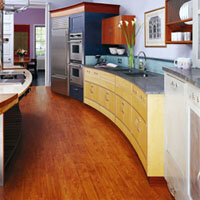 As we said above, laminate is an option for a kitchen, but it has drawbacks. The product is HDF/MDF backing with a photograph and a wear layer on top. It is ideal for kitchens because it is easy to maintain, is relatively scratch proof and requires only a mop to keep it clean. The downside is that if water gets to the backing it goes like cotton wool and expands, so you shouldn't really put laminate in heavy humidity areas. But the kitchen is the area that they tend to get put into most. However, be warned - if you have a washing machine leak which floods your kitchen you will lose your laminate floor, but then again there aren't many floor finishes that will survive a washing machine leak. If your back door leads into your kitchen, and you keep the door open so the dog can go out when it is pouring with rain then make sure you keep a mat down, otherwise it can get ruined. But a high percentage of the areas it goes in are kitchens, and it is successful. So, if you avoid getting it wet, it is a good floor for the kitchen, and if you get a good quality laminate then you should expect it to come with a 20 year warrantee.
As we said above, laminate is an option for a kitchen, but it has drawbacks. The product is HDF/MDF backing with a photograph and a wear layer on top. It is ideal for kitchens because it is easy to maintain, is relatively scratch proof and requires only a mop to keep it clean. The downside is that if water gets to the backing it goes like cotton wool and expands, so you shouldn't really put laminate in heavy humidity areas. But the kitchen is the area that they tend to get put into most. However, be warned - if you have a washing machine leak which floods your kitchen you will lose your laminate floor, but then again there aren't many floor finishes that will survive a washing machine leak. If your back door leads into your kitchen, and you keep the door open so the dog can go out when it is pouring with rain then make sure you keep a mat down, otherwise it can get ruined. But a high percentage of the areas it goes in are kitchens, and it is successful. So, if you avoid getting it wet, it is a good floor for the kitchen, and if you get a good quality laminate then you should expect it to come with a 20 year warrantee.
Remember, if you want underfloor heating in your kitchen, this is possible with laminate and LVT.
Lounge & Dining room
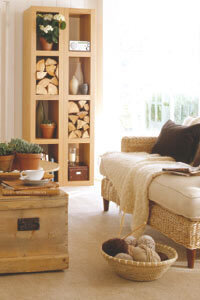 You can put anything in a lounge and dining – there is nothing that won't go! The key factor when it comes to choosing flooring for the lounge is what kind of look and feel you are after.
You can put anything in a lounge and dining – there is nothing that won't go! The key factor when it comes to choosing flooring for the lounge is what kind of look and feel you are after.
If you want softness and warmth then consider a carpet for your lounge. You should go for a high quality carpet, as the lounge is usually a key high traffic area of the home. Carpet caters for a wide range of budgets and colours to match any lounge.
If you want a hard floor for the lounge then laminate, wood floors and LVTs are all fine. If you choose a wood floor for your lounge then you can be sure that what you are going to get is unique. As it is from a tree, each piece is different. That also means you don't have any control over exactly how it will look. Anything you are shown in the showroom will only be representative of what you are going to get. You also need to bear in mind that it is prone to movement, and whilst it is long lasting, it is also higher maintenance than many other finishes. Wooden floors scratch, and that is part of the charm, beauty, natural ambience and aging process of a wooden floor. If you don't want a floor with scratches, a wood floor is not the floor for you.
Laminate is ideal for high traffic areas like the lounge because it is easy to maintain and easy to keep clean. All it requires is a mop. Within reason it is pretty scratch proof. It can sometimes have a bad name because of products on the market that have been manufactured to a low price point. If you avoid the cheap rubbish, a laminate floor is very good and very hard wearing and you should expect it to come with a 20 year warrantee.
Luxur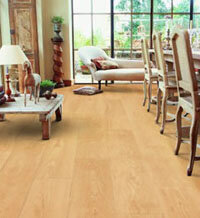 y Vinyl Tiles (LVTs) work particularly well in lounges and dining rooms. These are designer floors which have an incredible impact. People will walk in to your lounge or dining room, look at the floor and say "Wow! That is gorgeous!" Custom made, they are limited by your own imagination. You can choose your own design, add borders and motifs, change direction – it is limitless! For example, you can create a nice border so that the dining room table sits in the middle of the room with the border around it.
y Vinyl Tiles (LVTs) work particularly well in lounges and dining rooms. These are designer floors which have an incredible impact. People will walk in to your lounge or dining room, look at the floor and say "Wow! That is gorgeous!" Custom made, they are limited by your own imagination. You can choose your own design, add borders and motifs, change direction – it is limitless! For example, you can create a nice border so that the dining room table sits in the middle of the room with the border around it.
They are also very low maintenance as they only need a mop clean, and wear so well that after 25 or 30 years when maintained correctly they will still look like they were only laid yesterday. The only downside of an LVT floor is the price, because it is not an easy floor to fit. However, if the subfloor is in a good state then the price can be reasonable. In fact, if price wasn't an issue, everyone would probably have it, as it is a close as you can get to perfect in the hard flooring group. But remember, nothing is all things to all men, so consider what you want from your floor.
If you want underfloor heating in your lounge or dining room, you cannot have a solid wood floor, but you can have an engineered wood, laminate or LVT floor.
Hall
A wood floor is ideal for the hallway. This is because it has a fantastic impact on visitors when you open the front door and they see a lovely looking wood floor. However, if you choose to have a wood floor in the hall, get an outside doormat and an inside doormat, and make sure that people tread on those mats and not step over them, as if they travel dirt and grit into your wood floor, that's the same as having it sanded off and sealed.
It is worth bearing in mind that whilst a wood floor is incredibly long lasting, it is also higher maintenance and needs a lot of looking after, and refurbishment is not cheap. A wood floor will scratch, and if you don't want a floor that scratches, don't choose wood. The scratches are all part of the natural ambience, beauty, and aging process of a wood floor. A wood floor is prone to movement, but it is also unique, as it is a natural product that comes from a tree.
Vinyl is also a popular choice for a hallway because it is very 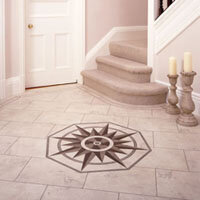 low maintenance. Vinyl is wipe clean, so all that is required to keep a vinyl floor clean is a mop. Vinyl doesn't mind water, and as the hallway is the area people come in to first with wet feet, it makes vinyl ideal. If you're worried that vinyl won't make a great first impression when someone walks through your front door then think again. Vinyl has come a long way since your grandmother's lino. Yes, you can buy cheap vinyl, but you can also buy good quality, hardwearing, robust vinyl. High quality vinyl floors are often textured, and many have an R10 rating, which means they are slip resistant. Some even come with a 15 year warranty!
low maintenance. Vinyl is wipe clean, so all that is required to keep a vinyl floor clean is a mop. Vinyl doesn't mind water, and as the hallway is the area people come in to first with wet feet, it makes vinyl ideal. If you're worried that vinyl won't make a great first impression when someone walks through your front door then think again. Vinyl has come a long way since your grandmother's lino. Yes, you can buy cheap vinyl, but you can also buy good quality, hardwearing, robust vinyl. High quality vinyl floors are often textured, and many have an R10 rating, which means they are slip resistant. Some even come with a 15 year warranty!
But there is no right or wrong answer when it comes to the hallway – it really depends on the size and layout of your house. Wood, carpet, laminate and vinyl are all great options.
Landing & Stairs
T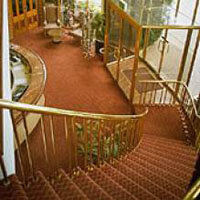 he majority of landings are carpet. In fact, the majority of upstairs areas – apart from wet areas – and stairs are carpet. This is because, as with the bedrooms, you are likely to be walking on the landing with bare feet. Carpet provides underfloor luxury, softness, warmth and comfort.
he majority of landings are carpet. In fact, the majority of upstairs areas – apart from wet areas – and stairs are carpet. This is because, as with the bedrooms, you are likely to be walking on the landing with bare feet. Carpet provides underfloor luxury, softness, warmth and comfort.
Lots of people also choose carpets for the stairs for the same reason. When selecting a carpet for the stairs and landing, make sure you choose a better quality carpet, as this is a high traffic area, with people walking up and down stairs several times on a daily basis.
Long pile carpets are a particularly popular choice on the stairs at the moment, but bear in mind that if you walk down stairs in socks, there is a chance that you can end up going full length.
Another popular choice for stairs at the moment is striped carpets, which work very well on staircases. But as with choosing carpet in any room of the home, you have to ask yourself will it still look nice in three years time, or is it just "of the moment"?
Other options for stairs include wood and laminate. There is a system whereby you can coat the stairs with laminate – in fact, it is quite popular to get the hall, stairs and landing all coated in laminate, which looks very good, although can be quite slippery. Having a laminate floor throughout these areas means it is easy to maintain the floors and easy to keep clean, as all they require is a mop. Within reason, laminate flooring is pretty scratch proof.
Conservatory
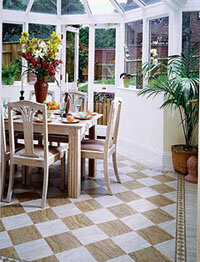 We would generally advise against a wood floor in a conservatory, although people do do it. This is because you shouldn't put wood where there is high humidity. Wood is hygroscopic, which means it works like a sponge. Wood will draw moisture from a heavy atmosphere and begin to gain volume and expand. When the atmosphere is dry, moisture is released out and the wood will begin to shrink. If you want to have wooden flooring in your conservatory, then we advise you opt for an engineered wooden floor rather than a solid wooden floor.
We would generally advise against a wood floor in a conservatory, although people do do it. This is because you shouldn't put wood where there is high humidity. Wood is hygroscopic, which means it works like a sponge. Wood will draw moisture from a heavy atmosphere and begin to gain volume and expand. When the atmosphere is dry, moisture is released out and the wood will begin to shrink. If you want to have wooden flooring in your conservatory, then we advise you opt for an engineered wooden floor rather than a solid wooden floor.
That aside, your choice of flooring for your conservatory really depends on how you use the room. Are you only going to sit in it and read on a sunny afternoon, or will it be a key living space? Is it a major thoroughfare – do you and your family use the door of the conservatory as the main entrance and exit to and from the house, or does the conservatory door remain locked most of the year round? Bear this in mind when choosing the type of flooring you want for your conservatory.
LVTs, carpets, vinyl and laminates are all fine for a conservatory. If you want underfloor heating in your conservatory, you cannot have a vinyl floor, but you can have a laminate or LVT floor.
Bathrooms and wet areas
If a customer asked us to fit wood in a bathroom or wet area we would categorically refuse. This is because wood is the least suitable flooring for a bathroom or wet area.
You should never put wood where there is high humidity – and the room with the highest humidity in the home is the bathroom. Wood is hygroscopic, which means it works like a sponge. Wood will draw moisture from a heavy atmosphere and begin to gain volume and expand. When the atmosphere is dry, moisture is released out and the wood will begin to shrink.
Laminate may not be the correct option if you have children and there is a lot of water about.
The two real options for a bathroom or wet area are patterned vinyls and LVTs.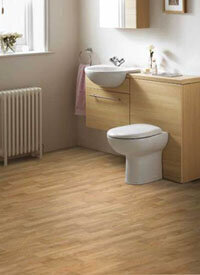
Luxury Vinyl Tiles (LVTs) are designer floors. They have an incredible impact, and are limited only by your own imagination. They have a great versatility in design, colour and style so you can choose the one that fits your preferred look, add borders and motifs, change its direction – it is limitless! They are very low maintenance, only needing a mop clean, and wear well. The only downside of an LVT floor is the price. This is because it is not an easy floor to fit, especially if the subfloor is in poor condition. But if the subfloor is in a good state then the price can be reasonable.
Vinyl is ideal for bathrooms, en-suites and WCs because they don't mind water. They require minimum maintenance, which means all that is required to keep them clean is a mop. Good quality vinyl tends to be hardwearing, often textured and usually comes with an R10 rating, meaning it is slip resistant, which makes it ideal for a bathroom or wet area.
If you want underfloor heating in your bathroom, you can have vinyl or LVT floor finishes.
Conclusion
We hope this guide has been a useful introduction to flooring for you and given you some tips to think about when choosing flooring for your home. However, it is not intended to replace speaking to experts.
Case Studies
Torsion
This was Student accommodation for Lincoln University fitting Rimini carpet tiles throughout the living accommodation with Gradus PVC nosings to the staircases. Safety flooring in shower areas and Luxury Vinyl Tiles to kitchens
Dixon Ward at Lincoln County Hospital
Another installation carried out by our experienced Contracts fitting team fitting Altro white rock to walls to form a totally hygienic surface.
Alive Church
Wall cladding in one of their family rooms with with gerfloor tara safe ultra non slip area for wet play with Lincolnshire flooring Ruston Tiles in colour lead.
Retail installation with Beautiful stair runner in Telenzo Carpet
Retail installation with Beautiful stair runner in Telenzo Carpet in colour Gravel finished off perfectly with some stair rods in colour Pewter.
Beautiful stripe carpet by Castlemead
Woodpecker engineered wood installation finished off with a complementary modern twist, beautiful stripe carpet by Castlemead in colour Velvet Stripe.

















